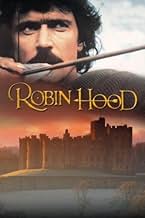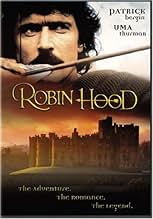The Swashbuckling legend of Robin Hood unfolds in the 12th century when the mighty Normans ruled England with an iron fist.The Swashbuckling legend of Robin Hood unfolds in the 12th century when the mighty Normans ruled England with an iron fist.The Swashbuckling legend of Robin Hood unfolds in the 12th century when the mighty Normans ruled England with an iron fist.
Danny Webb
- Much The Miller
- (as Daniel Webb)
Jürgen Prochnow
- Sir Miles Folcanet
- (as Jurgen Prochnow)
Jeroen Krabbé
- Baron Daguerre
- (as Jeroen Krabbe)
Storyline
Did you know
- TriviaMade the same year as Robin Hood: Prince of Thieves (1991) and thus did not receive a theatrical release in the United States.
- GoofsWoad (the purple dye Robin throws at the tax-collector) wouldn't have been around in the middle of the village. The process used to make the dye smelled so bad that woad-makers had to live outside the village to make it. Also, while in the cauldron it actually looks green, the indigo/purple colour only shows up as you remove the dyed item from the liquid, so the dye would not have appeared purple in the bowl before Robin threw it.
- Quotes
Maid Marian: So what are you going to do to me? Tie me up?
Robin Hood: Could be a lashing.
Maid Marian: How many strokes?
Robin Hood: As many as are necessary.
Maid Marian: And then it's finished?
Robin Hood: That depends. Have you ever been lashed before?
Maid Marian: I've never had someone make me beg them to stop.
Robin Hood: Then you've never had a proper lashing.
- Alternate versionsMade for cinematic release but competition from Robin Hood: Prince of Thieves (1991) ensured that it debuted on cable in the US (at 150 minutes) despite a cinema release elsewhere. USA videocassette version removes 34 minutes of footage.
Featured review
Robin Hood has come to the big screen in many ways and with many faces. Errol Flynn in 1938 remains the classic, although it is a little dated by modern standards. Kevin Costner starred in a big-budget 1991 version, notable for an outstanding Alan Rickman as an over-the-top sheriff but otherwise fairly forgettable. (If you're lucky.) I've seen most of them, and the best by far is Robin Hood, directed by John Irvin and likewise released in 1991. Patrick Bergin is a dynamic Robin Hood, hitting the mark with the perfect mix of arrogance, compassion, charm and devil-may-care, hell-bent glory-seeking. Sure, there's a list of noble reasons why Robin Hood takes to the forest to fight Norman oppression and protect the unfortunate Saxon serfs from tyranny. But let's face it, Robin is a hero who enjoys what he does. He loves nothing more than laughing at danger and tweaking the nose of authority. It's easy to see that Bergin enjoyed the part, and his pleasure translates to the screen, making it an enjoyable romp for viewers. Bergin shares Sherwood with a fine cast. Uma Thurman is a surprisingly strong Marian. Owen Teale is an excellent, fun-loving Will Scarlett, and David Morrissey is the best Little John I've seen yet. Jeff Nuttall is also a picture-perfect Friar Tuck. On the Norman side, Jurgen Prochnow is the malicious knight, Sir Miles Folcanet, who pursues Robin through the forest, and Jeroen Krabbe is Baron Daguerre, a greedy lord with a conscience. There's a brief, but impressive, appearance of Edward Fox as the would-be King John. The movie boasts excellent swordplay, good costuming, authentic-sounding accents (Are you listening, Kevin?) and some great pagan symbolism. This film also has immense respect for the history behind the legend. While we may not know much about the real Robin Hood -- if there even was one -- we do know a lot about the time period in question, and Irvin keeps his cameras focused on the truth of feudal Britain. This is a Robin Hood I can believe in without reservation.
- How long is Robin Hood?Powered by Alexa
Details
- Release date
- Countries of origin
- Language
- Also known as
- Робін Гуд
- Filming locations
- Peckforton Castle, Peckforton, Cheshire, England, UK(used as principle location)
- Production companies
- See more company credits at IMDbPro
Box office
- Budget
- $15,000,000 (estimated)
- Runtime1 hour 44 minutes
- Color
- Aspect ratio
- 1.85 : 1
Contribute to this page
Suggest an edit or add missing content
































